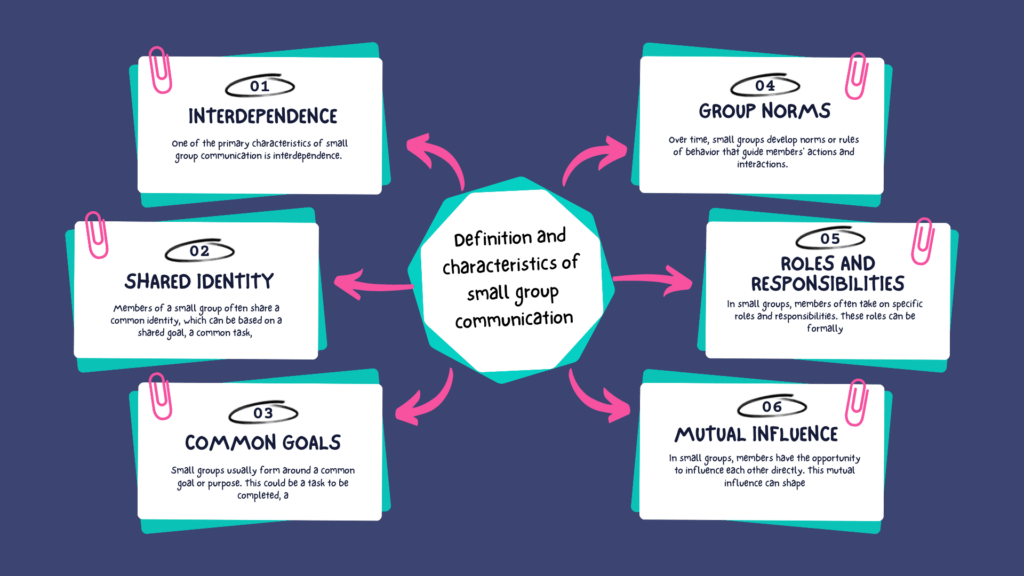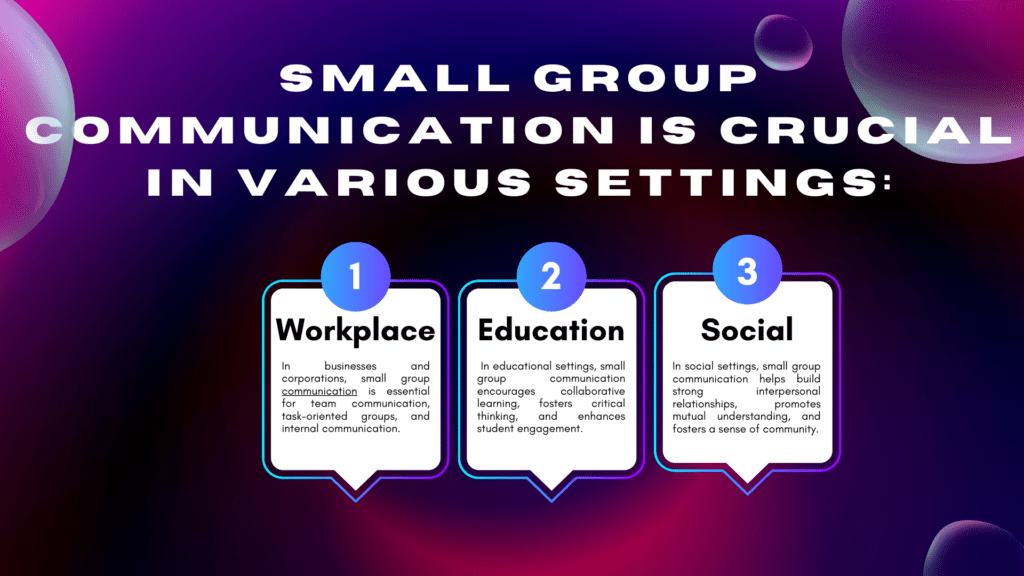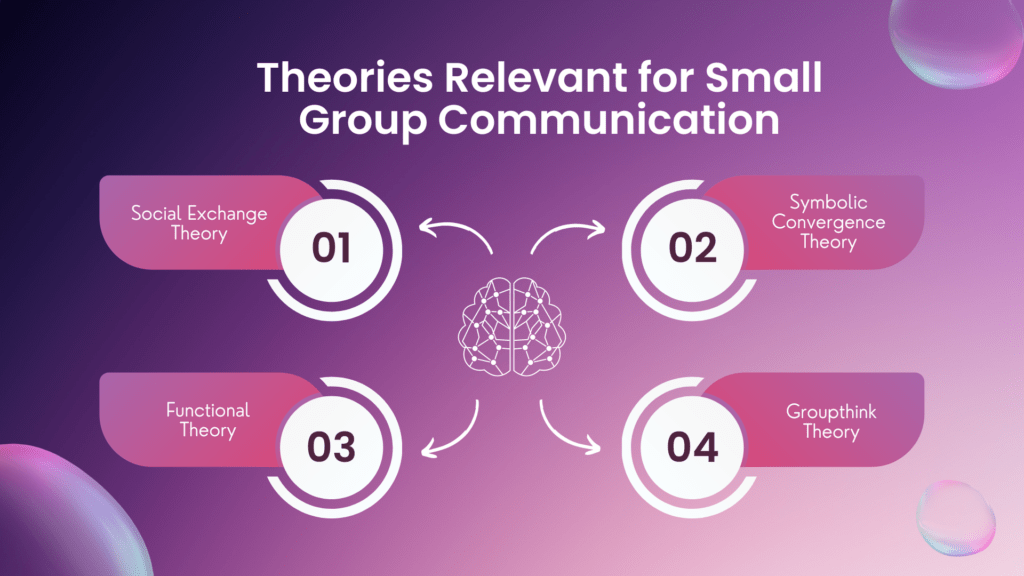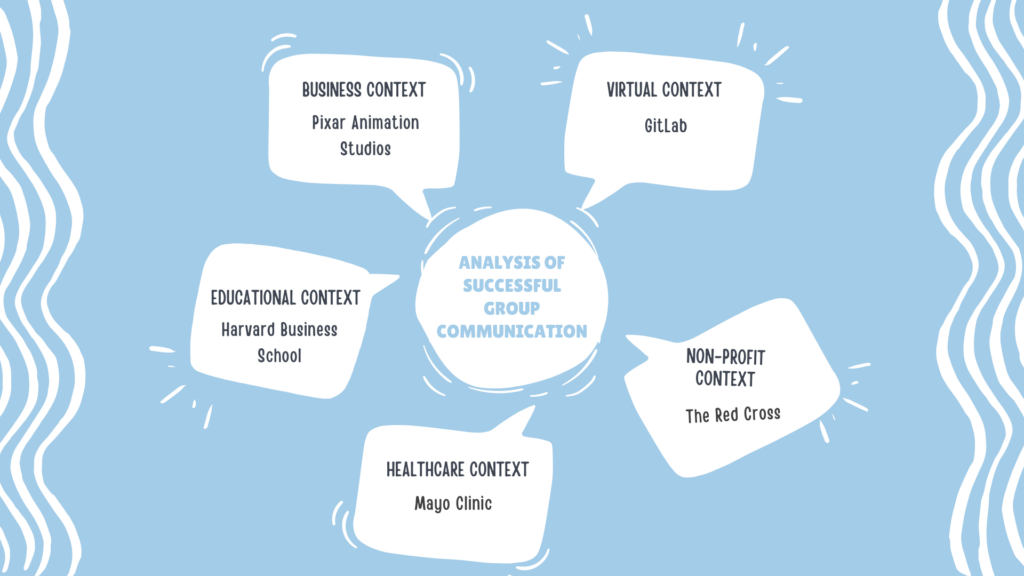Introduction
Small Group Communication: In today’s interconnected world, the ability to communicate effectively within small groups is more important than ever. Whether in a business setting, an educational institution, or a social gathering, the dynamics of group communication play a significant role in achieving interdependent goals and fostering strong interpersonal relationships. This blog post aims to shed light on the importance of effective small group communication, its key characteristics, and the benefits it brings to various aspects of our lives. We’ll also explore the challenges that can arise in small group communication and provide strategies to overcome them. By understanding and implementing effective small group communication, we can enhance our teamwork, improve decision-making, and ultimately, increase productivity and achievement.
Understanding Small Group Communication
Small group communication refers to the interaction that occurs within groups that are small enough for each member to participate actively, listen effectively, and have a direct influence on one another. Typically, these groups range in size from three to about twelve individuals. The characteristics of small group communication include interdependence, where each member’s actions affect the entire group, a shared identity, and a common group structure with roles and responsibilities.
Definition and characteristics of small group communication

Interdependence: One of the primary characteristics of small group communication is interdependence. This means that each member’s actions and behaviors can significantly affect the entire group. The success or failure of the group is often dependent on the collective efforts of its members.
Shared Identity: Members of a small group often share a common identity, which can be based on a shared goal, a common task, or a shared experience. This shared identity can foster a sense of belonging and cohesion among group members.
Common Goals: Small groups usually form around a common goal or purpose. This could be a task to be completed, a problem to be solved, or a decision to be made. The group’s success is often measured by its ability to achieve these goals.
Group Norms: Over time, small groups develop norms or rules of behavior that guide members’ actions and interactions. These norms can influence everything from how group members communicate to how they make decisions.
Roles and Responsibilities: In small groups, members often take on specific roles and responsibilities. These roles can be formally assigned or can emerge naturally over time. They can significantly influence the group’s dynamics and effectiveness.
Mutual Influence: In small groups, members have the opportunity to influence each other directly. This mutual influence can shape the group’s dynamics, decision-making processes, and overall effectiveness.
Small group communication is crucial in various settings:

- Workplace: In businesses and corporations, small group communication is essential for team communication, task-oriented groups, and internal communication. It facilitates decision-making, problem-solving, and task completion, leading to increased productivity and performance.
- Education: In educational settings, small group communication encourages collaborative learning, fosters critical thinking, and enhances student engagement.
- Social: In social settings, small group communication helps build strong interpersonal relationships, promotes mutual understanding, and fosters a sense of community.
Theories Relevant for Small Group Communication

Social Exchange Theory: This theory suggests that individuals seek to maximize their benefits and minimize their costs in interactions. In a small group, members will contribute more when they perceive that the benefits outweigh the costs.
Symbolic Convergence Theory: This theory explains how group communication can create a shared identity and group consciousness. Shared narratives or “fantasy themes” can help to build a group’s cohesion.
Functional Theory: This theory posits that effective decision-making in groups involves a series of critical functions, including problem analysis, goal setting, identification of alternatives, and evaluation of positive and negative characteristics of alternatives.
Groupthink Theory: This theory serves as a cautionary note about the potential negative effects of strong group cohesion, which can lead to poor decision-making due to pressure for conformity.
Benefits of Effective Small Group Communication
Enhanced problem-solving and decision-making processes
When communication flows freely in a small group, it becomes easier to share information, discuss different perspectives, and reach a consensus. This enhances the group’s ability to solve problems and make informed decisions, leading to better group outcomes.
Increased productivity and efficiency
Effective communication ensures that all group members understand their roles, responsibilities, and the group’s common purpose. This clarity reduces confusion and misunderstandings, leading to increased productivity and performance.
Strengthened relationships and team cohesion
Open and respectful communication fosters interpersonal relationships and builds team cohesion, creating a supportive and collaborative environment. This sense of cohesion and shared identity can create an in-group feeling, promoting positive group dynamics.
Fostering creativity and innovation
In a small group where communication is encouraged, team members feel more comfortable sharing their ideas and suggestions. This free exchange of ideas can lead to brainstorming, idea generation, and group ideation, fostering creative thinking and innovation.
Empowering individual members and promoting participation
Effective small group communication empowers individual members, making them feel valued and heard. This empowerment can lead to increased participation, with members more likely to contribute their ideas and take on responsibilities. This sense of mutual influence and accountability can lead to a more engaged and proactive team.
Elements of Effective Small Group Communication
Clear and purposeful communication goals
Every effective communication process within a small group starts with clear and purposeful communication goals. These goals provide a direction for the communication flow and help ensure that all group members are on the same page.
Active listening and effective feedback
Active listening is a crucial element of effective small group communication. It involves not just hearing but understanding and considering the views of others. Coupled with effective feedback, it ensures that all members feel heard and valued, fostering a sense of mutual influence and interdependence.
Open and respectful communication climate
An open and respectful communication climate encourages team members to express their thoughts and ideas without fear of judgment or criticism. This openness promotes trust, which is vital for effective group dynamics and decision-making.
Roles, norms, and responsibilities within the group
Understanding and respecting the roles, norms, and responsibilities within the group is crucial for effective small group communication. Clear roles and responsibilities help avoid confusion and ensure that tasks are completed efficiently.
Conflict resolution and managing disagreements
Disagreements are inevitable in any group. However, effective small group communication involves constructive conflict resolution strategies that turn disagreements into opportunities for growth and learning.
Use of appropriate communication channels and technology
In today’s digital age, virtual groups and online interaction have become increasingly common. Using appropriate communication channels and technology can enhance small group communication, making it more efficient and inclusive.
Challenges and Barriers in Small Group Communication
Lack of trust and cohesion
Trust is the foundation of any successful group. When trust is lacking, it can lead to a lack of cohesion, creating a divide among group members and hindering effective communication.
Communication breakdowns and misunderstandings
Communication breakdowns can occur due to various reasons, including unclear messages, ineffective listening, and lack of feedback. These breakdowns can lead to misunderstandings, causing confusion and conflict within the group.
Power dynamics and hierarchy
In some groups, power dynamics and hierarchy can create barriers to effective communication. When certain members dominate the conversation or decision-making process, it can lead to resentment and disengagement among other members.
Cultural and diversity issues
In diverse groups, cultural differences can sometimes lead to communication challenges. Misunderstandings can arise due to different communication styles, norms, and expectations. However, with respect and understanding, these differences can also enrich the group’s interactions.
Time constraints and scheduling conflicts
In today’s fast-paced world, finding a time when all group members can meet and communicate can be a challenge. This is especially true for virtual groups, where members might be spread across different time zones.
Strategies for Improving Small Group Communication
Establishing clear communication protocols and guidelines
One of the first steps towards improving small group communication is to establish clear communication protocols and guidelines. These protocols should outline the communication flow, the roles and responsibilities of each group member, and the norms and expectations for communication within the group. This clarity can help prevent misunderstandings and ensure that everyone is on the same page.
Building trust and rapport among group members
Trust is the foundation of effective communication. Building trust and rapport among group members can be achieved through open and honest communication, respect for each other’s ideas and opinions, and consistent follow-through on commitments. Regular team-building activities can also help strengthen relationships and build trust.
Encouraging active participation and equal voice
Every member of a small group brings unique perspectives and ideas to the table. Encouraging active participation and ensuring that everyone has an equal voice can foster a sense of ownership and engagement among group members. This can be achieved by creating a safe and inclusive communication climate where everyone feels comfortable sharing their thoughts and ideas.
Developing effective listening and feedback skills
Active listening and effective feedback are crucial for effective small group communication. Group members should be encouraged to listen attentively to each other and provide constructive feedback. Training sessions or workshops can be organized to help group members develop these skills.
Promoting cultural sensitivity and inclusivity
In diverse groups, cultural sensitivity and inclusivity are crucial. Group members should be encouraged to respect and value each other’s cultural backgrounds and perspectives. This can be achieved through diversity and inclusion training, as well as by fostering an open and respectful communication climate.
Managing conflicts constructively
Conflicts are inevitable in any group. However, they can be managed constructively through open communication, empathy, and respect for differing viewpoints. Conflict resolution strategies should be part of the group’s communication protocols, ensuring that disagreements are handled in a way that promotes growth and understanding rather than discord.
Utilizing technology and tools to facilitate communication
In today’s digital age, technology can play a significant role in facilitating small group communication. Tools like video conferencing platforms, project management apps, and collaborative software can make communication more efficient and inclusive, especially for virtual groups.
Case Studies and Examples of Small Group Communications
Real-life examples showcasing the impact of effective small group communication
Case Study 1: Google’s Project Aristotle
One of the most compelling real-life examples showcasing the impact of effective small group communication comes from Google’s Project Aristotle. In an attempt to understand what makes a team successful, Google conducted an extensive study analyzing data from hundreds of its teams. The surprising conclusion was that the most important factor wasn’t the individual skills or backgrounds of the team members, but the group’s communication dynamics. The highest-performing teams were those that exhibited high levels of psychological safety, a factor directly linked to open, respectful, and inclusive communication within the group. This case study underscores the importance of effective small group communication in fostering a successful team environment.
Case Study 2: NASA’s Mission Control Teams
NASA’s mission control teams provide another excellent example of effective small group communication. These teams, responsible for making critical decisions during space missions, are known for their effective communication practices. They have clear communication protocols and guidelines, a strong emphasis on active listening and effective feedback, and a commitment to managing conflicts constructively. Despite the high-pressure environment, these teams consistently demonstrate the ability to make sound decisions quickly, a testament to their effective small group communication practices.
Case Study 3: Virtual Teams in the Tech Industry
With the rise of remote work, virtual teams have become increasingly common, especially in the tech industry. Companies like Buffer and Automattic, which operate entirely remotely, have developed effective strategies for small group communication in a virtual context. These include using a variety of communication tools to facilitate both synchronous and asynchronous communication, establishing clear communication norms, and prioritizing transparency and inclusivity. Despite the challenges of remote work, these companies have managed to build successful teams, highlighting the potential of effective small group communication in a virtual context.
Analysis of successful group communication practices in different contexts

Business Context – Pixar Animation Studios: Pixar is renowned for its culture of creativity and innovation, much of which is attributed to its effective group communication practices. The company encourages open communication and active participation from all employees, regardless of their roles. This inclusive communication climate fosters creativity, as everyone feels comfortable sharing their ideas. Pixar’s “Braintrust” meetings, where constructive feedback is provided on ongoing projects, exemplify their commitment to effective group communication.
Educational Context – Harvard Business School: Harvard Business School utilizes the case method approach, where students learn in small groups. This method encourages active participation, open dialogue, and critical thinking. The small group communication skills that students develop in these settings – such as active listening, constructive feedback, and conflict resolution – are crucial for their future roles as business leaders.
Healthcare Context – Mayo Clinic: Mayo Clinic’s team-based approach to healthcare relies heavily on effective small group communication. Medical professionals from various specialties collaborate to provide comprehensive care for patients. Clear communication protocols, mutual respect, and a shared commitment to patient care facilitate effective decision-making and coordination among the team members.
Non-Profit Context – The Red Cross: The Red Cross operates with countless volunteers working in small groups across different regions. Effective group communication is crucial to coordinate efforts, especially during disaster response. The organization utilizes various communication channels and technology to facilitate information exchange and collaboration among its teams.
Virtual Context – GitLab: As one of the largest all-remote companies, GitLab faces unique communication challenges. The company addresses these by establishing clear communication guidelines, utilizing technology to facilitate communication, and promoting transparency. GitLab’s handbook, which is publicly available online, serves as a comprehensive guide for communication within the company.
Samrat is a Delhi-based MBA from the Indian Institute of Management. He is a Strategy, AI, and Marketing Enthusiast and passionately writes about core and emerging topics in Management studies. Reach out to his LinkedIn for a discussion or follow his Quora Page
